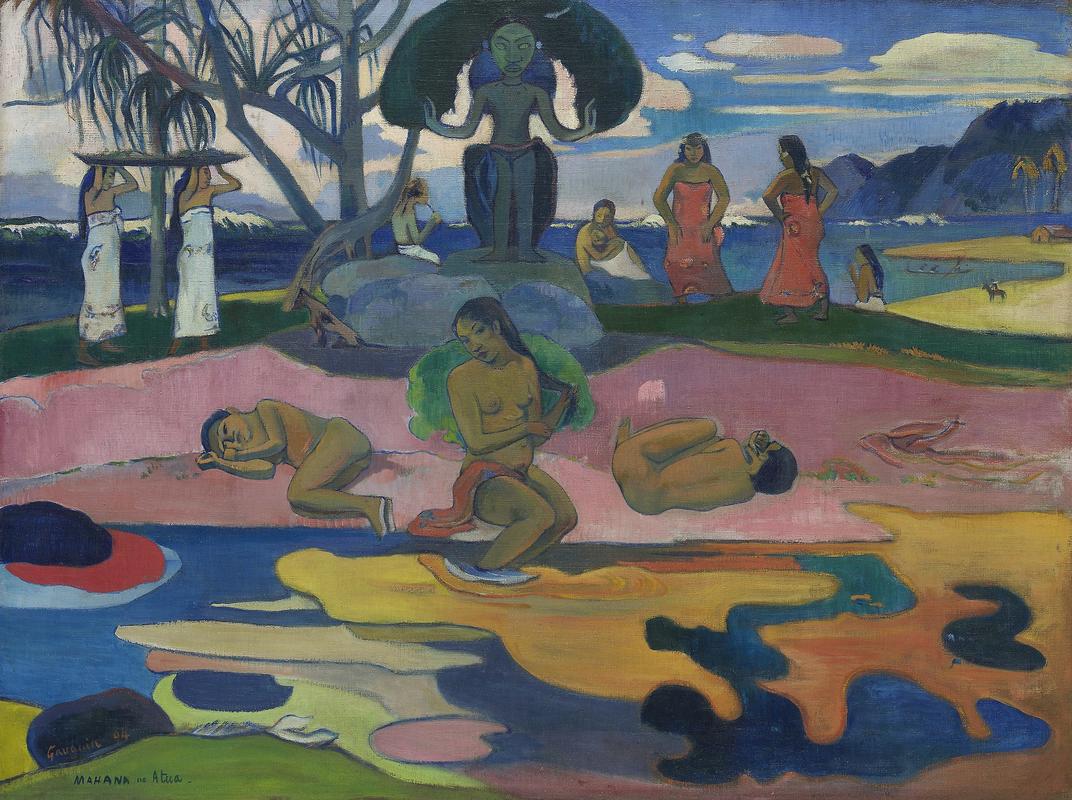More about Day of the God (Mahana no Atua)

Sr. Contributor
In this painting, Paul Gauguin depicts women dancing the upaupa, a dance banned by missionaries and colonial authorities.
Mahana no auta (Day of God) was a part of a series of Tahitian subjects that Paul Gauguin made in France between his stays in the South Pacific. At the time, he was struggling with his mental and physical health as well as his finances; he only painted 16 paintings in 1894, compared to 37 in 1892. He had become a social pariah after abandoning his wife and children in 1886 and had difficulty selling his works. After realizing that his glory days were behind him, he adopted an exotic persona and conducted a public affair with Anna the Javanese, one of his many mistresses he infected with syphilis, among them Tehura who, at the age of 14, could not really be considered a "mistress," more so a victim.
The scene depicted in Mahana no auta is imaginary - Gauguin’s sexual fantasy of the South Seas if you will. Gauguin’s signature style of contrasting hues, flat surfaces, and abstract shapes gives the painting a certain "primitive" sensuality central to Gauguin’s work, and exemplary of his colonial perspective of Tahitian people. The dominant discovery narrative of the time viewed the island natives as “primitive" as compared to Europeans. Tahitians, due to their fair skin were thought to be more generous and even tempered as compared to other Pacific peoples, though they were still oftentimes seen as indolent, and the women were still seen as sexually uninhibited or wanton.
In the foreground, there are three women sitting at the edge of a pond, who symbolize the three stages of life. To the left, the woman is in the fetal position with her toes barely touching represents birth and the beginning of life. In the middle, the woman is upright, with her feet in the water to represent living. On the right, the women is completely out of the water to represent death. The subject of life was a repeated theme in Gauguin’s work, most significantly in his final piece, Where Do We Come From? What Are We? Where Are We Going?
The idol of the goddess Hina is the center of the image, with Tahitian women dancing on the beach and carrying food behind her, possibly as an offering. The dance that the women are performing is thought to be the upaupa, an ancient Tahitian dance. In the 19th century, the dance had a bad reputation with Christian missionaries who attempted to suppress it, as they viewed the traditional music of the islands as belonging to the devil. Tahiti was viewed as a supernatural and superstitious land and many of their local traditions, including music and dance, were villainized. The rituals were grouped into a single monolith, without distinction between the many types and their purposes, all deemed guilty by association. The dancing, once thought of as immoral and obscene, has morphed into an ubiquitous symbol of Polynesia for tourists.
Imagination is a common thread in this painting, and the logic of Christian missionaries, as this dance that was attributed to Tahiti may not have even been Tahitian in origin. London Missionary Society representative William Wyatt Gill may have been referring to the Manihikian drum dance, the hupahupa, when writing that Cook Islanders' "great national amusement was the dance," commenting: “Respecting the morality of their dances, the less said the better; but the 'upaupa' dance, introduced from Tahiti, is obscene indeed.” In reality, the dance was likely not introduced to Tahiti until the late 18th century, possibly by the Manihikians. Regardless of the true origins of the dance, it was not spread throughout Polynesia until after pre-Christian times, and its romantic interpretation as a spiritual ancient ritual is more mythology than fact.
Sources
- Art Institute Chicago. “Mahana no atua (Day of the God).” Accessed February 16, 2021. https://www.artic.edu/artworks/27943/mahana-no-atua-day-of-the-god
- Eisenmen, Stephen F. “Elizabeth C. Childs, Vanishing Paradise: Art and Exorcism in Tahiti.” College Art Association. July 23, 2015. http://www.caareviews.org/reviews/2190.
- Gersh-Nesic, Beth. “A Chronological Timeline of Artist Paul Gauguin’s Life.” ThoughtCo. Updated January 16, 2021. https://www.thoughtco.com/paul-gauguin-timeline-183475.
- Lawrence, Helen Reeves. "Is the "Tahitian" Drum Dance Really Tahitian? Re-Evaluating the Evidence for the Origins of Contemporary Polynesian Drum Dance." Yearbook for Traditional Music 24 (1992): 126-37. doi:10.2307/768474.
- McLean, Mervyn. "Towards a Typology of Musical Change: Missionaries and Adjustive Response in Oceania." The World of Music 28, no. 1 (1986): 29-43. Accessed February 17, 2021. http://www.jstor.org/stable/43561083.
- PaulGauguin.org. “Paul Gauguin’s Day of God.” Accessed February 16, 2021. http://www.paulgauguin.org/day-of-the-god/
- Phipps, Peter. "Performing Indigenous Sovereignties across the Pacific." In Touring Pacific Cultures, edited by ALEXEYEFF KALISSA and TAYLOR JOHN, 245-66. Australia: ANU Press, 2016. Accessed February 17, 2021. http://www.jstor.org/stable/j.ctt1q1crs3.19.
Featured Content
Here is what Wikipedia says about Mahana no atua
Mahana no atua (English: Day of the God) is an 1894 oil painting by the French Post-Impressionist artist Paul Gauguin which is in the collection of the Art Institute of Chicago.
The painting was executed in Paris on Gauguin's return from his first period of living and working in Tahiti and is more imaginative than real. It depicts a central carved idol of the goddess Hina standing on a rock by the beach around which human figures are arranged in a symmetrical pattern. On the left two women are bearing votive offerings and on the right two others are dancing the upaupa, an erotic Tahitian dance which the colonial authorities tried to ban. In the foreground is an enigmatic group of three bathers, whose poses suggest they represent birth, life and death, but about which Gauguin never spoke.
In style the work is typical of the artist's Post-Impressionism in its simplification of forms and the dramatic use of color.
Check out the full Wikipedia article about Mahana no atua












